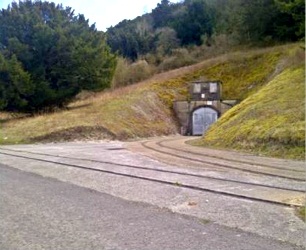Crown Fine Art’s innovative storage facility, hewn into the hillside of a former Royal Navy defence depot, has to be one of the most unusual, but also one the most secure, in the country.
The site started life in 1938 as a Royal Navy Armaments Depot, just at a time when Britain was bracing itself for war against Germany. Twenty four vaults were created over a three-year period by local labourers with help from Irish miners and Scottish fitters.
As recently as 1999 it was storing and processing weapons for all three military services but in 2004 was deemed surplus to requirements, and converted for civilian use.
These days it provides a real alternative for museums who want to store art and artefacts outside of city centres where fire, flood and even terrorism provide unpredictable risks.

The Dean Hill vaults are part of a high security site, inspected and approved for items covered by the Government Indemnity Scheme.
Totally devoid of sunlight and only accessible via internal entrance tunnels, they include bespoke dehumidifier systems to create a controlled and stable environment.
The vaults also feature anti-spark lighting, CCTV, fire and security alarms as well as overhead gantry cranes to make the placing and removal of objects as risk-free as possible.
Crown Fine Art’s Special Projects Manager Michael Festenstein said: “The vaults have a fascinating history but the important thing for our clients is they are the perfect place to store art and museum pieces safely.The temperature and humidity is easy to control and the site is highly secure.”
Crown Fine Art, which provides secure transportation, storage, installation and de-installation services for the world’s museums, art galleries, auction houses and private collectors, says the facility provides many advantages.
Michael Festenstein added: “With the cost of insuring vulnerable artworks soaring, placing objects in a sanctuary where their safekeeping can be assured is becoming ever more important.
“A lot of museums are looking to move their stored items out of the city; and insurance costs can be reduced by the use of a secure external facility.
“It’s amazing to think that vaults were designed for a very different purpose, with weapons stored there in the past. But what better legacy could the peace process have given the arts than this superb, safe storage for invaluable artefacts?”
Back to top




